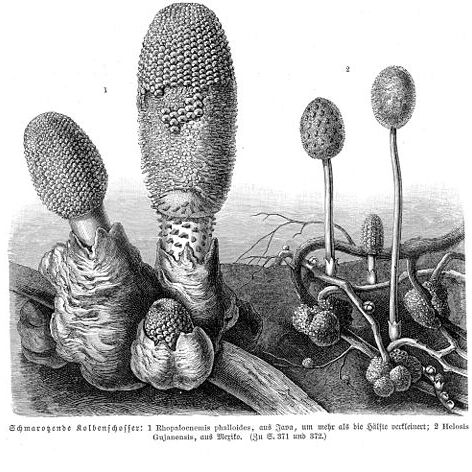Rhizome filiform to digitiform, often intertwined, rich in starch, yellowish to brownish. Inflorescence monoecious, claviform, the peduncle thick, generally encircled at the base or at the middle with a glabrous, toothed to lobed, oblique sheath (rarely absent), the head globose, ovoid or ellipsoid, when immature covered with 6-sided, peltate, umbonate scales beneath which occurs a dense mat of para-physoid trichomes and young developing flowers, the scales spirally arranged, deciduous, about the axis of each scale are oriented two whorls containing many pistillate flowers surrounded by a single whorl of 6 flowers which are situated at the angles of the covering scale and are either rudimentary or functionally stami-nate. Perianth in the staminate flowers composed of 3 (or 6) tepals connate in the lower half into a tube, the lobes becoming widely reflexed; in the pistillate flowers reduced to a low bilabiate epigynous collar or, according to some authors, absent. Stamens as many as the perianth lobes and opposite them, exserted, the filaments adnate to the perianth tube below, free or connate into a staminal column, generally free above, the anthers united into a synandrium, each with two posterior and a single anterior pollen sac, introrse; absent in the pistillate flowers. Pistil 2-carpellate, the ovary compressed, the ovules 2, fused to the ovary wall, generally only one maturing, the styles 2, filiform, spreading, deciduous, the stigmas globose or capitate; pistillode sometimes present in the staminate flowers, often very reduced. Fruit nut-like, compressed, with crusty epicarp and hard endocarp.
More
Subterranean tubers, 4-5 x 3-4 cm, giving out rhizome-like structures from which inflorescences appear at various intervals. Supraterranean, inflorescence-bearing stems 5-15 cm long and 0.5-1 cm diam., basally with 2-6 minute, triangular scales. Inflorescences ellipsoid-ovoid, 2-10 x 1-3 cm, covered by the flattened, marginally cohering, hexagonal limbs of peltate, petiolate, early deciduous bracts; each bract subtending an extremely depressed, hardly discernible branch delimitated by imaginary lines between the petioles of 4 neighbouring bracts; branch bisexual and proterogynous. Flowers embedded in a layer of thin, narrowly clavate hairs. Staminate flowers with perianth tubular below, 3-lobed with ligulate segments; stamens 3, filaments united into a tubular column inserted in the perianth tube, anthers connate into a 9-locular synandrium. Pistillate flower with perianth adnate to ovary, 2 short and broadly ligulate segments protruding above compressed ovary; styles 2, filiform, appearing above layer of hairs.

